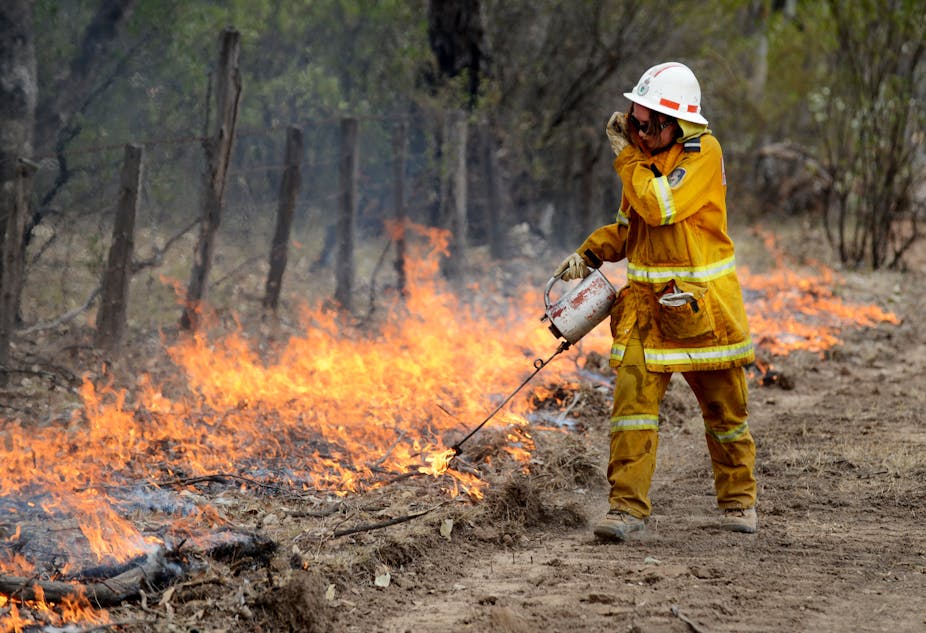Fires are an inescapable part of life in Australia; they have been occurring for millennia, and regardless of our actions, they will continue.
Much of the vegetation in Australia has evolved to be tolerant of fire, so much so that many species now need it to flourish. In fact, the traits of many Australian plants actively encourage the spread of fire.
As a result, in many parts of the country it is not a matter of if a fire will occur, it is a matter of when. This inevitability results in a complex problem for Australian society. Some fire impacts can be resolved through active management. However society must decide on the level of management intervention and expenditure that it is prepared to bear. Likewise, not all negative outcomes can be prevented, so society must decide on the level of impact that it is prepared to accept.
Recent research has questioned current levels of expenditure on fire management. In theory, finding the ideal level of expenditure is simply a matter of weighing up all the costs and benefits. Increased spending on preparedness (such as education, firefighting and fuel management) is assumed to result in a net reduction in impact (including losses of property, productivity, lives and suppression expenditure and ecological costs and benefits).
The optimal preparedness expenditure is simply that in which preparedness expenditures plus expected fire losses results in the lowest cost for society.

In the real world, fires burn under changing weather conditions through a complex physical environment. They also have impacts on a wide variety of things humans value. Consequently, finding the true cost of a fire is not necessarily a straightforward process.
An expenditure-impact approach assumes that the trade-offs between fire prevention and impacts are known and can be measured in terms of dollars. It also assumes that each fire protection dollar is invested in such a way that it can yield no greater benefit. However, in practice determining the ideal investment is highly complex.
While the potential for fire to affect human society can be easily understood, the true cost of fire is far more difficult to measure. Some effects can be quite tangible, such as the loss of dwellings, assets, livestock and agricultural productivity. Others are not so, such as the value of human lives, perceived “naturalness” and security, air quality, carbon, water quality, ecological values and ecosystem services. Preparedness measures that involve prescribed fire can also have inadvertent impacts on these values.
It also needs to be recognised that impacts are not all negative, some, particularly ecological, can be positive. For example, since the Victorian Black Saturday bushfires, some rare plant species such as the Lake Mountain grevillia and the alpine wattle have flourished. Understanding the impacts on society of a single fire, let alone the trade-offs involved in long term fire planning, is no simple matter; it is a complex potpourri of economics, ecology and sociology.
Likewise, investment in fire prevention can take a wide variety of forms. Education, regulation and enforcement can help reduce ignitions, help make dwellings more defensible and guide decision-making. Investment in firefighting resources can help detect and curtail the growth of existing fires. Investment in prescribed burning can have ecological benefits and assist with fire control.

The complex interface between the natural, fire-prone world and the human environment means that it is no simple task to tease apart the importance of various fire preparedness measures. The effectiveness of strategies may vary under different conditions; under some conditions prescribed burning may be an effective way of reducing fire ferocity to manageable levels, in others it may be less so.
The intrinsic uncertainty of natural systems contribute to this; for example, the efficacy of a prescribed burn may vary based on the season of burning, the length of time since burning and the size and position of the burnt area in the landscape. Likewise, different preparedness strategies contribute to managing fire in different ways and with different costs. No method is likely to be ideal in isolation. It is likely that the best strategy will be a combination of approaches, however finding the ideal mix is no simple task.
So how do we resolve the conundrum of fire management? How do we our invest limited resources to get the best outcome possible?
First we need to accept fire as an intrinsic part of the landscape; it will remain a regular (albeit sometimes unwelcome) visitor. It cannot be considered an adversary that can be defeated.
Second, we need to define goals in a clear, and measurable manner, and design strategies to achieve those goals. Included in this must be recognition of the values that we may have to sacrifice. We need to monitor the results so that we can more clearly understand our approaches and the trade-offs we are making and respond accordingly. We also need to understand that our natural environment is complex and can be unpredictable, and that things may not always behave as we expect.
Above all, we need to move towards a more comprehensive understanding of fire and what it means to the things that we, as a society, value.

